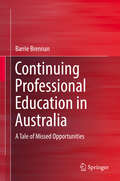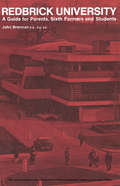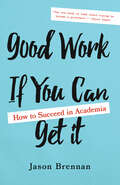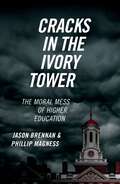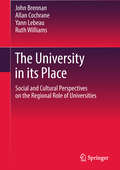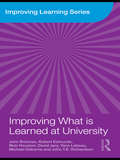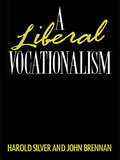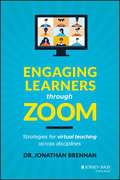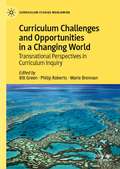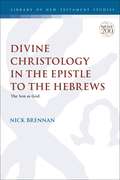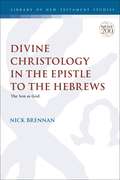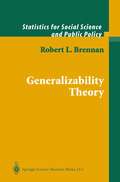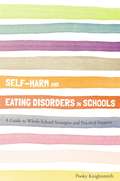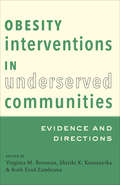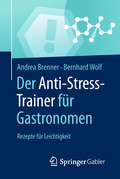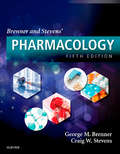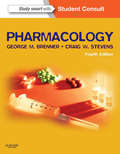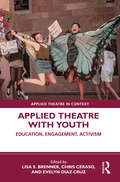- Table View
- List View
Continuing Professional Education in Australia: A Tale of Missed Opportunities
by Barrie BrennanThis book offers a history of Continuing Professional Development (CPD) in the Australian context. It presents an approach that links the development of CPD to a series of 'missed opportunities' and the identification of three key themes (mandatory CPD, competencies and regulation/registration) as well as with national regulation for select health professions. It not only relates the evolution of CPD in Australia but also serves as a guide to examining the situation in other countries and the emergence of CPD in individual professions. CPD has been provided for many decades, but it has not been rated as a 'high priority' or a key area of provision and has not been the focus of discussions or disputes in the higher education sector or in vocational education circles. Nevertheless in describing CPD's development, evidence is presented that CPD has made a significant contribution to the broad field of vocational education.
Redbrick University: A Guide for Parents, Sixth-Formers and Students
by J. A. BrennanRedbrick University: A Guide for Parents, Sixth-Formers and Students provides constructive criticism of the Redbrick University. This book serves as a guide to young students on the attractions of university life as well as the difficulties ahead. Organized into 11 chapters, this book begins with an overview of the predicaments faced by students in their initial months in the university. This text then describes the important observation that a university teacher needs to improve his or her status regularly within the university, and, in order to merit academic promotion, he or she must produce a substantial amount of original research. Other chapters consider the relative values of the different types of accommodation available to young students. The final chapter presents the various classifications of the societies and clubs at the university, including sport, recreation, cultural, political, and religious societies. This book is a valuable resource for teachers, parents and students.
Good Work If You Can Get It: How to Succeed in Academia
by Jason BrennanDo you want to go to graduate school? Then you're in good company: nearly 80,000 students will begin pursuing a PhD this year alone. But while almost all of new PhD students say they want to work in academia, most are destined for disappointment. The hard truth is that half will quit or fail to get their degree, and most graduates will never find a full-time academic job. In Good Work If You Can Get It, Jason Brennan combines personal experience with the latest higher education research to help you understand what graduate school and the academy are really like. This candid, pull-no-punches book answers questions big and small, including• Should I go to graduate school—and what will I do once I get there?• How much does a PhD cost—and should I pay for one?• What kinds of jobs are there after grad school, and who gets them? • What happens to the people who never get full-time professorships? • What does it take to be productive, to publish continually at a high level? • What does it take to teach many classes at once? • What does it take to succeed in graduate school? • How does "publish or perish" work? • How much do professors get paid?• What do search committees look for, and what turns them off? • How do I know which journals and book publishers matter? • How do I balance work and life?This realistic, data-driven look at university teaching and research will make your graduate and postgraduate experience a success. Good Work If You Can Get It is the guidebook anyone considering graduate school, already in grad school, starting as a new professor, or advising graduate students needs. Read it, and you will come away ready to hit the ground running.
Good Work If You Can Get It: How to Succeed in Academia
by Jason BrennanDo you want to go to graduate school? Then you're in good company: nearly 80,000 students will begin pursuing a PhD this year alone. But while almost all of new PhD students say they want to work in academia, most are destined for disappointment. The hard truth is that half will quit or fail to get their degree, and most graduates will never find a full-time academic job. In Good Work If You Can Get It, Jason Brennan combines personal experience with the latest higher education research to help you understand what graduate school and the academy are really like. This candid, pull-no-punches book answers questions big and small, including• Should I go to graduate school—and what will I do once I get there?• How much does a PhD cost—and should I pay for one?• What kinds of jobs are there after grad school, and who gets them? • What happens to the people who never get full-time professorships? • What does it take to be productive, to publish continually at a high level? • What does it take to teach many classes at once? • What does it take to succeed in graduate school? • How does "publish or perish" work? • How much do professors get paid?• What do search committees look for, and what turns them off? • How do I know which journals and book publishers matter? • How do I balance work and life?This realistic, data-driven look at university teaching and research will make your graduate and postgraduate experience a success. Good Work If You Can Get It is the guidebook anyone considering graduate school, already in grad school, starting as a new professor, or advising graduate students needs. Read it, and you will come away ready to hit the ground running.
Good Work If You Can Get It: How to Succeed in Academia
by Jason BrennanWhat does it really take to get a job in academia?Do you want to go to graduate school? Then you're in good company: nearly 80,000 students will begin pursuing a PhD this year alone. But while almost all new PhD students say they want to work in academia, most are destined for something else. The hard truth is that half will quit or fail to get their degree, and most graduates will never find a full-time academic job. In Good Work If You Can Get It, Jason Brennan combines personal experience with the latest higher education research to help you understand what graduate school and the academy are really like. This candid, pull-no-punches book answers questions big and small, including• Should I go to graduate school—and what will I do once I get there?• How much does a PhD cost—and should I pay for one?• What does it take to succeed in graduate school? • What kinds of jobs are there after grad school—and who gets them? • What happens to the people who never get full-time professorships? • What does it take to be productive, to publish continually at a high level? • What does it take to teach many classes at once? • How does "publish or perish" work? • How much do professors get paid?• What do search committees look for, and what turns them off? • How do I know which journals and book publishers matter? • How do I balance work and life?This realistic, data-driven look at university teaching and research will help make your graduate and postgraduate experience a success. Good Work If You Can Get It is the guidebook that anyone considering graduate school, already in grad school, starting as a new professor, or advising graduate students needs. Read it, and you will come away ready to hit the ground running.
Good Work If You Can Get It: How to Succeed in Academia
by Jason BrennanWhat does it really take to get a job in academia?Do you want to go to graduate school? Then you're in good company: nearly 80,000 students will begin pursuing a PhD this year alone. But while almost all new PhD students say they want to work in academia, most are destined for something else. The hard truth is that half will quit or fail to get their degree, and most graduates will never find a full-time academic job. In Good Work If You Can Get It, Jason Brennan combines personal experience with the latest higher education research to help you understand what graduate school and the academy are really like. This candid, pull-no-punches book answers questions big and small, including• Should I go to graduate school—and what will I do once I get there?• How much does a PhD cost—and should I pay for one?• What does it take to succeed in graduate school? • What kinds of jobs are there after grad school—and who gets them? • What happens to the people who never get full-time professorships? • What does it take to be productive, to publish continually at a high level? • What does it take to teach many classes at once? • How does "publish or perish" work? • How much do professors get paid?• What do search committees look for, and what turns them off? • How do I know which journals and book publishers matter? • How do I balance work and life?This realistic, data-driven look at university teaching and research will help make your graduate and postgraduate experience a success. Good Work If You Can Get It is the guidebook that anyone considering graduate school, already in grad school, starting as a new professor, or advising graduate students needs. Read it, and you will come away ready to hit the ground running.
Cracks in the Ivory Tower: The Moral Mess of Higher Education
by Jason Brennan Phillip MagnessAcademics extol high-minded ideals, such as serving the common good and promoting social justice. Universities aim to be centers of learning that find the best and brightest students, treat them fairly, and equip them with the knowledge they need to lead better lives. But as Jason Brennan and Phillip Magness show in Cracks in the Ivory Tower, American universities fall far short of this ideal. At almost every level, they find that students, professors, and administrators are guided by self-interest rather than ethical concerns. College bureaucratic structures also often incentivize and reward bad behavior, while disincentivizing and even punishing good behavior. Most students, faculty, and administrators are out to serve themselves and pass their costs onto others. The problems are deep and pervasive: most academic marketing and advertising is semi-fraudulent. To justify their own pay raises and higher budgets, administrators hire expensive and unnecessary staff. Faculty exploit students for tuition dollars through gen-ed requirements. Students hardly learn anything and cheating is pervasive. At every level, academics disguise their pursuit of self-interest with high-faluting moral language. Marshaling an array of data, Brennan and Magness expose many of the ethical failings of academia and in turn reshape our understanding of how such high power institutions run their business. Everyone knows academia is dysfunctional. Brennan and Magness show the problems are worse than anyone realized. Academics have only themselves to blame.
CRACKS IN THE IVORY TOWER C: The Moral Mess of Higher Education
by Jason Brennan Phillip MagnessAcademics extol high-minded ideals, such as serving the common good and promoting social justice. Universities aim to be centers of learning that find the best and brightest students, treat them fairly, and equip them with the knowledge they need to lead better lives. But as Jason Brennan and Phillip Magness show in Cracks in the Ivory Tower, American universities fall far short of this ideal. At almost every level, they find that students, professors, and administrators are guided by self-interest rather than ethical concerns. College bureaucratic structures also often incentivize and reward bad behavior, while disincentivizing and even punishing good behavior. Most students, faculty, and administrators are out to serve themselves and pass their costs onto others. The problems are deep and pervasive: most academic marketing and advertising is semi-fraudulent. To justify their own pay raises and higher budgets, administrators hire expensive and unnecessary staff. Faculty exploit students for tuition dollars through gen-ed requirements. Students hardly learn anything and cheating is pervasive. At every level, academics disguise their pursuit of self-interest with high-faluting moral language. Marshaling an array of data, Brennan and Magness expose many of the ethical failings of academia and in turn reshape our understanding of how such high power institutions run their business. Everyone knows academia is dysfunctional. Brennan and Magness show the problems are worse than anyone realized. Academics have only themselves to blame.
The University in its Place: Social and Cultural Perspectives on the Regional Role of Universities (Higher Education Dynamics Ser.)
by John Brennan Allan Cochrane Yann Lebeau Ruth WilliamsThis book sets out to understand the significance of geographical context – place – for universities in the globalised setting of the twenty-first century. It examines their social impact on the regions in which they are situated, both from the perspectives of the universities themselves and from the perspectives of a range of different local and regional interest groups. It draws on a national study in the UK which has examined the role played by universities in four contrasting regional contexts. This UK study will be set within the larger theoretical and international literature on the role played by universities in processes of social change and transformation. An important theme of the book is the effects of university activities on various socially disadvantaged groups and consideration is given to whether there are ‘winners’ and ‘losers’ arising from the activities and interventions of universities. The book distinguishes between ‘discourses’, ‘activities’ and their ‘impacts’ in considering the role of universities and emphasises the importance of history and context as important mediators of national and institutional policies. It examines some of the key partnerships which universities enter into within their regions and considers some of the factors which determine the nature of these partnerships. Implications are drawn out for university leaderships and for regional and national policy bodies. The book provides empirical evidence in a field marked by a considerable amount of rhetoric from interested parties. One of the book’s conclusions is that there is considerable diversity among higher education institutions in how they perform a regional role, but it is a significant question for each of them. Institutional variation and regional setting come together to shape what is achievable.
Improving What is Learned at University: An Exploration of the Social and Organisational Diversity of University Education (Improving Learning)
by John Brennan Robert Edmunds Muir Houston David Jary Yann Lebeau Michael Osborne John T.E. RichardsonReceived the ‘highly commended’ award by the Society for Educational Studies for books published in 2010. What is learned in universities today? Is it what students expect to learn? Is it what universities say they learn? How far do the answers to questions such as these differ according to what, where and how one studies? As higher education has expanded, it has diversified both in terms of its institutional forms and the characteristics of its students. However, what we do not know is the extent to which it has also diversified in terms of ‘what is learned’. In this book, the authors explore this question through the voices of higher education students, using empirical data from students taking 15 different courses at different universities across three subject areas – bioscience, business studies and sociology. The study concentrates on the students’ experiences, lives, hopes and aspirations while at university through data from interviews and questionnaires, and this is collated and assessed alongside the perspectives of their teachers and official data from the universities they attend. Through this study the authors provide insights into ‘what is really learned at university’ and how much it differs between individual students and the universities they attend. Notions of ‘best’ or ‘top’ universities are challenged throughout, and both diversities and commonalities of being a student are demonstrated. Posing important questions for higher education institutions about the experiences of their students and the consequences for graduates and society, this book is compelling reading for all those involved in higher education, providing conclusions which do not always follow conventional lines of thought about diversity and difference in UK higher education.
Improving What is Learned at University: An Exploration of the Social and Organisational Diversity of University Education (Improving Learning #Vol. 10)
by John Brennan Robert Edmunds Muir Houston David Jary Yann Lebeau Michael Osborne John T.E. RichardsonReceived the ‘highly commended’ award by the Society for Educational Studies for books published in 2010. What is learned in universities today? Is it what students expect to learn? Is it what universities say they learn? How far do the answers to questions such as these differ according to what, where and how one studies? As higher education has expanded, it has diversified both in terms of its institutional forms and the characteristics of its students. However, what we do not know is the extent to which it has also diversified in terms of ‘what is learned’. In this book, the authors explore this question through the voices of higher education students, using empirical data from students taking 15 different courses at different universities across three subject areas – bioscience, business studies and sociology. The study concentrates on the students’ experiences, lives, hopes and aspirations while at university through data from interviews and questionnaires, and this is collated and assessed alongside the perspectives of their teachers and official data from the universities they attend. Through this study the authors provide insights into ‘what is really learned at university’ and how much it differs between individual students and the universities they attend. Notions of ‘best’ or ‘top’ universities are challenged throughout, and both diversities and commonalities of being a student are demonstrated. Posing important questions for higher education institutions about the experiences of their students and the consequences for graduates and society, this book is compelling reading for all those involved in higher education, providing conclusions which do not always follow conventional lines of thought about diversity and difference in UK higher education.
A Liberal Vocationalism
by John Brennan Harold SilverAims to rescue a usable interpretation of the vocational theory in higher education by describing the historical and policy frameworks of the debate.
A Liberal Vocationalism
by John Brennan Harold SilverAims to rescue a usable interpretation of the vocational theory in higher education by describing the historical and policy frameworks of the debate.
Engaging Learners through Zoom: Strategies for Virtual Teaching Across Disciplines
by Jonathan BrennanKeep your virtual students focused and meaningfully engaged with this invaluable teaching resource Engaging Learners through Zoom delivers numerous practical strategies and helpful advice on how to engage students virtually. Many of the tools are also applicable in face-to-face and hybrid environments. Backed by cognitive neuroscience research, this book is a collection of dozens of active, synchronous online learning structures that can be used in any discipline, perfect for K-12 through higher education. This book provides teachers, college educators, administrators, and trainers the antidote to Zoom fatigue! Transform Zoom (or any video-conferencing platform) into an ideal environment for students to focus more fully, learn more effectively and have more fun! Dr. Brennan, accomplished author, professor and distance education expert, improves learner performance and addresses equity in education with: Over 150 active learning strategy examples with step-by-step directions Ideas for including diverse content across 83 different disciplines Multiple examples for 26 of the most commonly taught courses Engaging Learners through Zoom belongs in the collection of every educator who wants to motivate and inspire their students to excel in a virtual learning environment.
Engaging Learners through Zoom: Strategies for Virtual Teaching Across Disciplines
by Jonathan BrennanKeep your virtual students focused and meaningfully engaged with this invaluable teaching resource Engaging Learners through Zoom delivers numerous practical strategies and helpful advice on how to engage students virtually. Many of the tools are also applicable in face-to-face and hybrid environments. Backed by cognitive neuroscience research, this book is a collection of dozens of active, synchronous online learning structures that can be used in any discipline, perfect for K-12 through higher education. This book provides teachers, college educators, administrators, and trainers the antidote to Zoom fatigue! Transform Zoom (or any video-conferencing platform) into an ideal environment for students to focus more fully, learn more effectively and have more fun! Dr. Brennan, accomplished author, professor and distance education expert, improves learner performance and addresses equity in education with: Over 150 active learning strategy examples with step-by-step directions Ideas for including diverse content across 83 different disciplines Multiple examples for 26 of the most commonly taught courses Engaging Learners through Zoom belongs in the collection of every educator who wants to motivate and inspire their students to excel in a virtual learning environment.
Curriculum Challenges and Opportunities in a Changing World: Transnational Perspectives in Curriculum Inquiry (Curriculum Studies Worldwide)
by Marie Brennan Bill Green Philip RobertsThis book brings together voices and perspectives from across the world and draws in a new generation of curriculum scholars to provide fresh insight into the contemporary field. By opening up Curriculum Studies with contributions from twelve countries—including every continent—the book outlines and exemplifies the challenges and opportunities for transnational curriculum inquiry. While curriculum remains largely shaped and enabled nationally, global policy borrowing and scholarly exchange continue to influence local practice. Contributors explore major shared debates and future implications through four key sections: Decolonising the Curriculum; Knowledge Questions and Curriculum Dilemmas; Nation, History, Curriculum; and Curriculum Challenges for the Future.
Divine Christology in the Epistle to the Hebrews: The Son as God (The Library of New Testament Studies)
by Nick BrennanNick Brennan investigates the depiction of the Son's divine nature in the Epistle to the Hebrews; despite little attention being directly given to the Son's divinity in recent study of Hebrews, Brennan argues that not only is the Son depicted as divine in the Epistle, but that this depiction ranges outside the early chapters in which it is most often noted, and is theologically relevant to the pattern of the Author's argument.Beginning with a survey of the state of contemporary scholarship on the Son's divinity in Hebrews, and a discussion of the issues connected to predicating divinity of the Son in the Epistle, Brennan analyses the application of Old Testament texts to the Son which, in their original context, refer to God (1:6; 10–12), and demonstrates how the Pastor not only affirms the Son's divinity but also the significance of his exaltation as God. He then discusses how Heb 3:3, 4 witnesses to the divinity of the Son in Hebrews, explores debates on the relation of the Son's “indestructible life” (Heb 7:16) to his divinity, and demonstrates how two key concepts in Hebrews (covenant and sonship) reinforce the Son's divinity. Brennan thus concludes that the Epistle not only portrays the Son as God, but does so in a manner which is a pervasive aspect of its thought, and is theologically salient to many features of the Epistle's argument.
Divine Christology in the Epistle to the Hebrews: The Son as God (The Library of New Testament Studies)
by Nick BrennanNick Brennan investigates the depiction of the Son's divine nature in the Epistle to the Hebrews; despite little attention being directly given to the Son's divinity in recent study of Hebrews, Brennan argues that not only is the Son depicted as divine in the Epistle, but that this depiction ranges outside the early chapters in which it is most often noted, and is theologically relevant to the pattern of the Author's argument.Beginning with a survey of the state of contemporary scholarship on the Son's divinity in Hebrews, and a discussion of the issues connected to predicating divinity of the Son in the Epistle, Brennan analyses the application of Old Testament texts to the Son which, in their original context, refer to God (1:6; 10–12), and demonstrates how the Pastor not only affirms the Son's divinity but also the significance of his exaltation as God. He then discusses how Heb 3:3, 4 witnesses to the divinity of the Son in Hebrews, explores debates on the relation of the Son's “indestructible life” (Heb 7:16) to his divinity, and demonstrates how two key concepts in Hebrews (covenant and sonship) reinforce the Son's divinity. Brennan thus concludes that the Epistle not only portrays the Son as God, but does so in a manner which is a pervasive aspect of its thought, and is theologically salient to many features of the Epistle's argument.
Generalizability Theory (Statistics for Social and Behavioral Sciences)
by Robert L. BrennanGeneralizability theory offers an extensive conceptual framework and a powerful set of statistical procedures for characterizing and quantifying the fallibility of measurements. Robert Brennan, the author, has written the most comprehensive and up-to-date treatment of generalizability theory. The book provides a synthesis of those parts of the statistical literature that are directly applicable to generalizability theory. The principal intended audience is measurement practitioners and graduate students in the behavioral and social sciences, although a few examples and references are provided from other fields. Readers will benefit from some familiarity with classical test theory and analysis of variance, but the treatment of most topics does not presume specific background.
Self-Harm and Eating Disorders in Schools: A Guide to Whole-School Strategies and Practical Support
by Sarah Brennan Pooky KnightsmithSelf-harm and eating disorders are present in almost every school and they frequently co-occur. This book provides the vital guidance that school staff need to spot early warning signs, understand triggers and support the students in their care effectively. This very practical guide helps educational professionals to gain a better understanding of self-harm and eating disorders by dispelling the myths and misconceptions that surround these behaviours. The book provides advice on whole-school policies and procedures as well as day-to-day strategies to implement in lessons, at mealtimes and in one-on-one sessions. It explains how to respond to disclosures, make referrals and work alongside parents to assist in the road to recovery.
Obesity Interventions in Underserved Communities: Evidence and Directions
by Virginia M. Brennan Shiriki K. Kumanyika Ruth Enid ZambranaThe obesity epidemic has a disproportionate impact on communities that are hard-hit by social and economic disadvantages. In Obesity Interventions in Underserved Communities, a diverse group of researchers explores effective models for treating and preventing obesity in such communities. The volume provides overviews of the literature at specific junctures of society and health (e.g., the effectiveness of preschool obesity prevention programs), as well as commentaries that shape our understanding of particular parts of the obesity epidemic and field reports on innovative approaches to combating obesity in racial/ethnic minority and other medically underserved populations in the United States. Authors make specific recommendations to policy makers which are designed to reverse the rising rate of obesity dramatically. The thirty-one literature reviews, commentaries, and field reports collected here address obesity prevention and treatment programs implemented across a spectrum of underserved populations, with particular attention paid to children and adolescents. Aimed at students, clinicians, and community workers in public health and health policy, as well as family medicine and pediatrics, sociology, childhood education, and nutrition—and deeply informed by fieldwork—this book demonstrates the importance of taking a full contextual view, both historical and current, when considering the challenge of reversing upward obesity trends among ethnic minorities, impoverished people, and other underserved populations.
Der Anti-Stress-Trainer für Gastronomen: Rezepte für Leichtigkeit (Anti-Stress-Trainer)
by Andrea Brenner Bernhard Wolf Peter BuchenauDieses Buch aus der Anti-Stress-Trainer-Reihe wurde von Gastronomen für Gastronomen geschrieben. Die beiden Autoren haben selbst in einem kleinen Familienbetrieb den stressigen Alltag hautnah erlebt. Mit allen Facetten der zwischenmenschlichen Beziehungen im eigenen Team und mit den Gästen entpuppen sich viele alltägliche Situationen als Stressbringer. Leider bleibt oft keine Zeit, sich schon an der Wurzel darum zu kümmern und zu erkunden wie und wo der Stress entsteht. Erst bei Eskalationen einzugreifen, ist sehr zeitaufwendig und meist ist das Kind schon in den Brunnen gefallen. Dieser Ratgeber gibt dem Leser aus der Branche mit vielen Beispielen und Abhilfetipps einfache und pragmatische Lösungen an die Hand . Nicht alle auf einmal, sondern wohldosiert je nach Zeit und Möglichkeiten, können Gastronomen kapitelweise lesen und ausprobieren. Die Autoren erzählen eigene Geschichten sowie Erfahrungen und welche Methoden sie als Gastronomen und Coaches angewendet haben, um Stresssituationen zu erkennen und für die Zukunft zu verringern. Immer geschrieben mit einem für die Branche üblichen Augenzwinkern und einer Portion Selbstironie.
Brenner and Stevens’ Pharmacology E-Book
by George M. Brenner Craig W. StevensDesigned to help you learn and retain key information in pharmacology, this foundational text takes you from course exams and the USMLE Step 1 right through to clinical practice. Brenner and Stevens’ Pharmacology, 5th Edition, focuses on the essential principles you need to know, in a concise yet comprehensive manner that’s easy to understand. Highly illustrated and formatted for quick reference, it’s your go-to text for the must-know aspects of pharmacology you’ll need for clinical problem solving and decision making. Teaches the fundamental aspects of pharmacology using full-color illustrations, detailed explanations, and a consistent format to present classification of drugs for each system/disease. Features useful tables, drug classifications boxes, case studies, and self-assessments in each chapter to help you review and prepare for course exams and Step 1. Includes the latest pharmacologic mechanisms and applications with new and updated drug information throughout
Pharmacology E-Book: with STUDENT CONSULT Online Access
by George M. Brenner Craig W. StevensPharmacology, 4th Edition helps you master the "must-know" concepts in this subject and how they apply to everyday clinical problem solving and decision making. This concise yet comprehensive text clearly explains and illustrates challenging concepts and helps you retain the material - from course exams and the USMLE Step 1 right through to clinical practice.Consult this title on your favorite e-reader with intuitive search tools and adjustable font sizes. Elsevier eBooks provide instant portable access to your entire library, no matter what device you're using or where you're located.Quickly reference essential information thanks to abundant tables throughout, and drug classification boxes at the beginning of each chapter.See how pharmacology applies to practice with real-world case studies.Prepare for exams with self-assessment questions at the end of each chapter.Understand complex concepts visually with the aid of superb full-color illustrations.Access the complete contents online at www.studentconsult.com, along with an additional glossary, chapter-by-chapter summaries and case studies, a full list of featured drugs, 150 USMLE-style questions, animations, and more.Learn the latest pharmacologic mechanisms and applications with new and updated drug information throughout.Be aware of new "off label" uses, including important FDA regulations.
Applied Theatre with Youth: Education, Engagement, Activism (Applied Theatre in Context)
by Lisa S. Brenner Chris Ceraso Evelyn Diaz CruzApplied Theatre with Youth is a collection of essays that highlight the value and efficacy of applied theatre with young people in a broad range of settings, addressing challenges and offering concrete solutions. This book tackles the vital issues of our time—including, among others, racism, climate crisis, gun violence, immigration, and gender—fostering dialogue, promoting education, and inciting social change. The book is divided into thematic sections, each opening with an essay addressing a range of questions about the benefits, challenges, and learning opportunities of a particular type of applied theatre. These are followed by response essays from theatre practitioners, discussing how their own approach aligns with and/or diverges from that of the initial essay. Each section then ends with a moderated roundtable discussion between the essays’ authors, further exploring the themes, issues, and ideas that they have introduced. With its accessible format and clear language, Applied Theatre with Youth is a valuable resource for theatre practitioners and the growing number of theatre companies with education and community engagement programs. Additionally, it provides essential reading for teachers and students in a myriad of fields: education, theatre, civic engagement, criminal justice, sociology, women and gender studies, environmental studies, disability studies, ethnicity and race studies.
